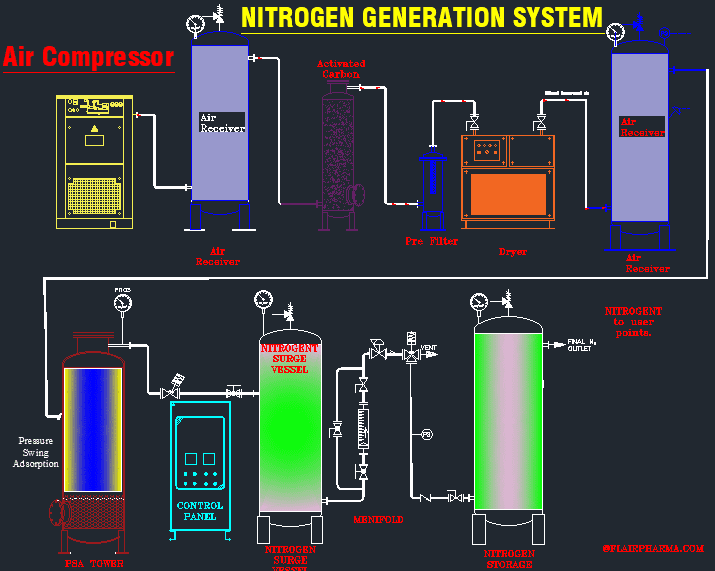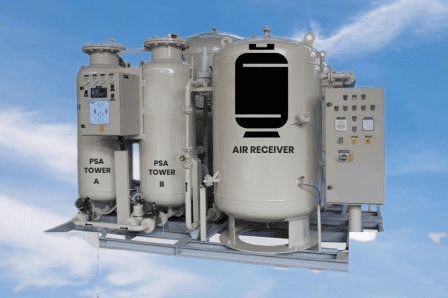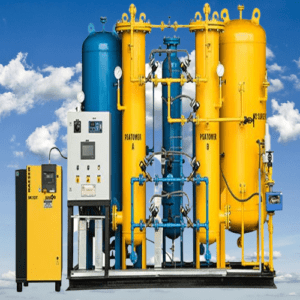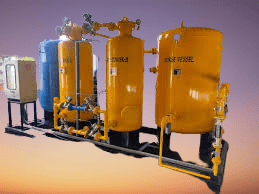Nitrogen gas is an inert gas that is almost non-reactive to other substances. These properties increase the utilization of nitrogen, from raw material preparation, and intermediate processes to final product packaging in Pharma industries. So the plant installed in the industry generates pharmaceutical-grade nitrogen. In manufacturing, unit nitrogen is used for purging and blanketing which increases the shelf life of that particular product. This nitrogen gas testing is as per the N2 gas specification of USP, Ip, BP, etc. ISO also provides the iso guideline for nitrogen in pharmaceuticals. So Nitrogen Plant purity is a very important aspect of pharmaceuticals. All pharmacopeia like USP, BP, IP, etc. have a description of the purity and testing and its limits.
Key parameters and important Limits of Nitrogen:
The followings are the test parameters and the limits for pure nitrogen plants in pharmaceuticals.
| S.N. | Test Parameter | Limit |
| 1 | Appearance | Colorless, Odorless Gas |
| 2 | Identification of properties (by physical test) | The flame of the burning wood splinter is extinguished when inserted into a test tube filled with nitrogen. |
| 3 | Carbon dioxide (CO2) | NMT 300 PPM v/v |
| 4 | Carbon monoxide (CO) | NMT 5 PPM v/v |
| 5 | Oxygen (O2) | NMT 50 PPM v/v |
| 6 | Moisture Content | NMT 67 PPM v/v |
| 7 | Assay (By GC) | Not less than 99.5 % v/v |
| 8 | Total non-viable particle count (Maximum permitted no. of particles/m³of air) ≥ 0.5 µm | 3520 |
| 9 | Total non-viable particle count (Maximum permitted no. of particles/m³of air) ≥ 5.0 µm | 20 |
| Sterility | Should be sterile |
| Bio-burden | NMT 01 CFU/plates/m³ |
In Injectable plants, during the production of sterile products, to avoid atmospheric contamination, positive pressure is created with Nitrogen.
This positive pressure creation prevents the product from ingress of air, thereby eliminating the risk of contamination.
Nitrogen gas(N2) impact on the Pharma Products:
N2 reduces the effect of oxygen or moisture. Nitrogen is used to replace the air in the void space and thus increasing the stability/shelf life of the drug product. N2 is help to keep products dry and sterile, hence improving their durability.
Technology to Generate the Nitrogen Gas:
We all know the atmospheric air contains 78% of Nitrogen and 21% of Oxygen. So that the challenge is the separation of oxygen and nitrogen.
The most used and trusted technology available in the market is PSA technology to separate Oxygen and Nitrogen from the air. PSA means “ Pressure Swing Adsorption“.
The PSA system has a special Molecular sieve that has selective adsorption affinity for the adsorption of Oxygen molecules and lets the Nitrogen go out.
This phenomenon of adsorption of oxygen gas molecules on the adsorbent is under pressure and is known as Pressure Swing Adsorption (PSA).
Major Components of Nitrogen Plant Storage & Distribution System:
- Air compressor.
- Air receiver with Pressure Gauge, Safety Valve, and Pressure Switch.
PSA Nitrogen Plant:
- Air Dryer.
- Dryer With PSA Tower.
- Dust and Oil Removal Filter and Pre-filter.
- Twin Tower PSA Module with Automatic Change over valves.
- Surge Vessel with drain valve and instruments.
- CMS (Carbon Molecular Sieves ) & Activated Alumina One Charge filled in PSA Towers.
- Nitrogen 3 Way Vent Valve, Back Pressure Controller, Pressure switches, Pressure gauges, Safety valve.
- Interconnecting Piping within the skid.
- Metal Tube Flow meters for nitrogen with flow control valve.
- Centralized control panel with sequence programmer.
- Online Oxygen Analyzer.

Storage & Distribution Lines of Nitrogen Plant:
- Storage tank.
- Filtration Set, at the header. ( 5 Micron, 1.2 microns,s and 0.22 microns)
- Distribution line (Aluminum, SS, GI or PPR, etc.)
- End user 0.2 Micron filter
Components description and their use of the Nitrogen Plant:
| S. No. | Description | Purpose |
| 1 | Pre-filter | 5 Micron filter with SS 304 housing to be provided at the outlet of the air receiver |
| 2 | Fine filter | 1Micron filter cartridge with SS304 housing to be provided on the line after the 5-micron filter for the supply of air which is absolutely free from dust/foreign particles and tiny water droplets. |
| 3 | PSA Tower | Required to absorb oxygen molecules at a faster rate than nitrogen molecules. In order to facilitate the continuous generation of nitrogen gas. |
| 4 | Nitrogen Receiver | For the collection of N2 gas. |
| 5 | Oxygen Analyzer | Required monitoring of the N2 gas purity. |
| 6 | GI/SS/PPR/Aluminum/Silicon transfer pipe | To carry over the nitrogen gas from the Air receiver to the utility header line. |
| 7 | SS 304/316L distributions line | To carry the nitrogen gas from the header to the user point |
| 8 | 0.22-micron filters installed in the distribution line, and the user point. | To arrest the particles |
Working Flow Process of Nitrogen Plant:-
Step1. :- Firstly air compressor takes air from the atmosphere and compresses it to a pressure of 6 to 8 kg/cm2.
Step2.:- Depending on the kind and choice of compressor, the air compressor has after-coolers (either water- or air-cooled), which cool the hot compressed air and cause physical moisture to condense.
The physical moisture that has thusly condensed is sorted out in the moisture separator, where an auto drain valve directs it into the atmosphere.
Step 3.:- After that, the dust and oil contaminants are removed by a filter.
Step 4.:- The filtered air now is allowed to pass through an air dryer where all the moisture is removed – The air dryer can be desiccant or refrigeration
Step 5.:- In the nitrogen plant, the PSA module can now accommodate the passage of this clean, dry air. Module for the basic PSA Nitrogen Generator.
In the PSA module, dry air enters one of the adsorption towers where compressed air is allowed to pass over the adsorbent (carbon molecular sieve).
After a minute, the tower becomes saturated with oxygen, and as a result, the tower is automatically switched to another tower for oxygen adsorption and nitrogen generation.
Thus, it is permitted for the prior tower, which is overflowing with oxygen, to release the gas into the atmosphere.
Step 6. :- This process is a continuous process that’s why surge vessels get a regular supply of nitrogen from the PSA tower and collect it.
Step 7.:- An online oxygen analyzer examines the nitrogen for the presence of oxygen impurities (and moisture if desired; dew-point testing is optional) ( & online dew-point Meter) If the nitrogen meets the required quality standards, it is then permitted to enter a storage tank.
Step 8.:-The system is equipped with a vent valve that prevents nitrogen of undesirable quality from entering storage and subsequently being used. Until the desired purity was reached, it let the impure nitrogen vent out.
Step 9.:- You can use the nitrogen from the storage tank. Pressure switches are installed in storage tanks, stopping the plant if the pressure is excessive and restarting it if the pressure drops below the predetermined level.

Nitrogen plants used in the pharmaceutical industry typically employ a cryogenic distillation process to separate nitrogen from the air. This involves compressing and cooling air to the point where it liquefies and then distilling the liquid air to separate the nitrogen from other components such as oxygen and argon.
The purified nitrogen gas is then stored in high-pressure tanks and distributed to various parts of the pharmaceutical production process. Nitrogen gas is commonly used to create an inert environment during the manufacturing, packaging, and storage of pharmaceutical products, as it helps to prevent oxidation and degradation of the active ingredients.
Nitrogen plants in pharmaceuticals must also adhere to strict regulations and quality control standards, such as those set forth by the Food and Drug Administration (FDA) and the International Organization for Standardization (ISO). This ensures that the nitrogen gas produced by the plant is of high purity and meets the necessary specifications for use in pharmaceutical applications.
Overall, nitrogen plants are a critical component of the pharmaceutical industry, as they help to ensure the safety and quality of pharmaceutical products by providing a reliable source of high-purity nitrogen gas.
Critical Process Control of Nitrogen Plant:
- Fault alarm
- Air Temperature High
- The oxygen percentage is high.
- Pressure in the surge vessel is high
- Pressure in the storage tank
Documents required for Nitrogen Plant.
- DQ, IQ, OQ, BOM List, P&ID, GA drawings,
- Calibration certificates,
- MOC Certificates,
- Operation manual & maintenance manual.
- Guaranty /warranty certificates. etc
Performance Qualification tests:
The parameters required for the performance qualification (PQ) of a nitrogen gas plant in pharma depend on the specific application and requirements of the pharmaceutical manufacturing process. However, some general parameters that may be evaluated during PQ include:
Nitrogen purity: The purity of nitrogen gas produced by the plant should be measured and verified to ensure that it meets the required specification. The purity can be measured using analytical techniques such as gas chromatography.
Nitrogen flow rate: The flow rate of nitrogen gas should be measured and verified to ensure that it meets the required specifications for the particular pharmaceutical manufacturing process.
Pressure: The pressure of the nitrogen gas should be measured and verified to ensure that it meets the required specifications.
Moisture content: The moisture content of the nitrogen gas should be measured and verified to ensure that it meets the required specifications for the particular pharmaceutical manufacturing process.
Particulate matter: The presence of any particulate matter in the nitrogen gas should be measured and verified to ensure that it is within acceptable limits for the particular pharmaceutical manufacturing process.
Microbial content: The microbial content of the nitrogen gas should be measured and verified to ensure that it is within acceptable limits for the particular pharmaceutical manufacturing process.
Overall, the PQ of a nitrogen gas plant in pharma involves verifying that the system can consistently produce nitrogen gas of the required quality and purity for the specific pharmaceutical manufacturing process. The parameters evaluated during PQ may vary depending on the specific application and regulatory requirements.
FAQ:
What is a nitrogen plant in the pharmaceutical industry?
Answer: Nitrogen plant is used for the generation of the pharmacopeial gare nitrogen gas which is used as an excipient to the product like ampoules, vials of blister packs tablets, or sachets.
How does a nitrogen plant work?
Answer: The nitrogen plant works to generate Nitrogen Gas by the PSA technique as described above step by step.
What is nitrogen used for in medicine?
Answer: Nitrogen is used for the Blanketing, purging of products, and for product transfer activities in pharma plants.
Why is nitrogen N2 purging needed in pharmaceuticals?
Answer: The fact is that nitrogen is a dry, inert gas and doesn’t react with other elements is one of its greatest advantages. As a result, oxygen and other potentially dangerous or unwanted atmospheric gases can be effectively replaced with N2. Nitrogen lessens the presence of oxygen, which could act as a catalyst for combustion or have a negative impact on the quality of the final product.
What is nitrogen used for in pharmaceuticals?
Answer: N2 is used for Blanketing. By substituting nitrogen for oxygen, nitrogen blanketing minimizes the amount of oxygen present. This keeps the high-purity pharmaceutical materials pure throughout the manufacturing process by preventing quick oxidation, corrosion, and rust, suppressing fire, assisting in the prevention of combustion, and in other ways. Nitrogen Purging, a method frequently employed, involves taking the oxygen out of the packing before closing it. This helps to preserve the goods throughout travel and protects it from airborne contamination. Pharmaceutical products packaged in blisters, test kits for doctor’s offices, blood supplies, specimen containers, and sterile medical equipment are a few examples that are regularly packaged with nitrogen gas. N2 is also used for safe product transfer.
Why nitrogen is important for pharmaceutical industry?
Answer: N2 increase the shelf life and quality of the parma product. Also, help to prevent the product from contamination. N2 helps to manufacture the high- purity quality product for the pharma industry.
What are pharmaceutical gases?
Answer: The pharmaceutical gases are Compressed air, Nitrogen (N), Xenon (Xe), Hydrogen (H), Argon (Ar), Nitric Oxide (NO), Carbon Dioxide (CO2), Oxygen (O2), Nitrous Oxide (N2O), and Helium (He).
If you want more information about the Nitrogen Plant or the best OEM nitrogen plant in India, Please write us at: admin@flairpharma.com


can u mail me this sheet